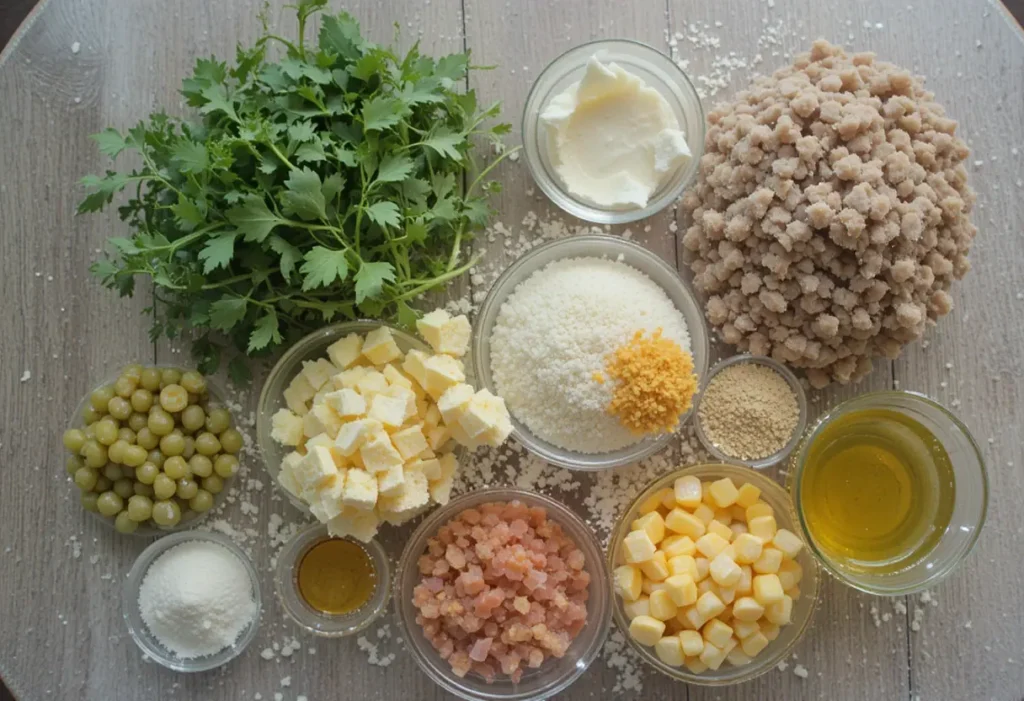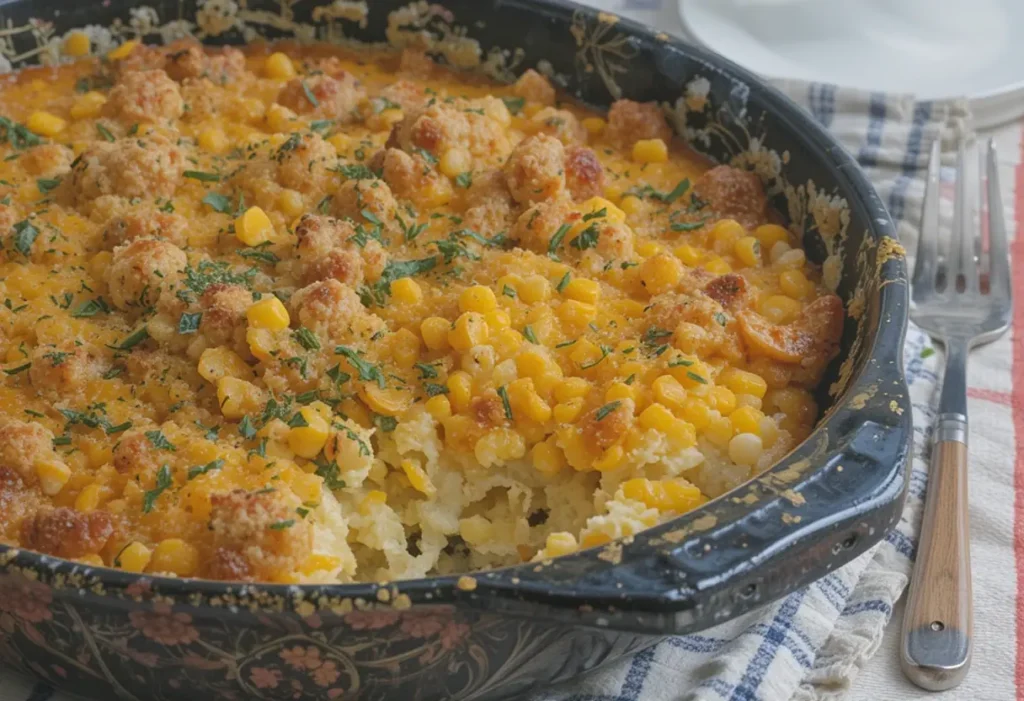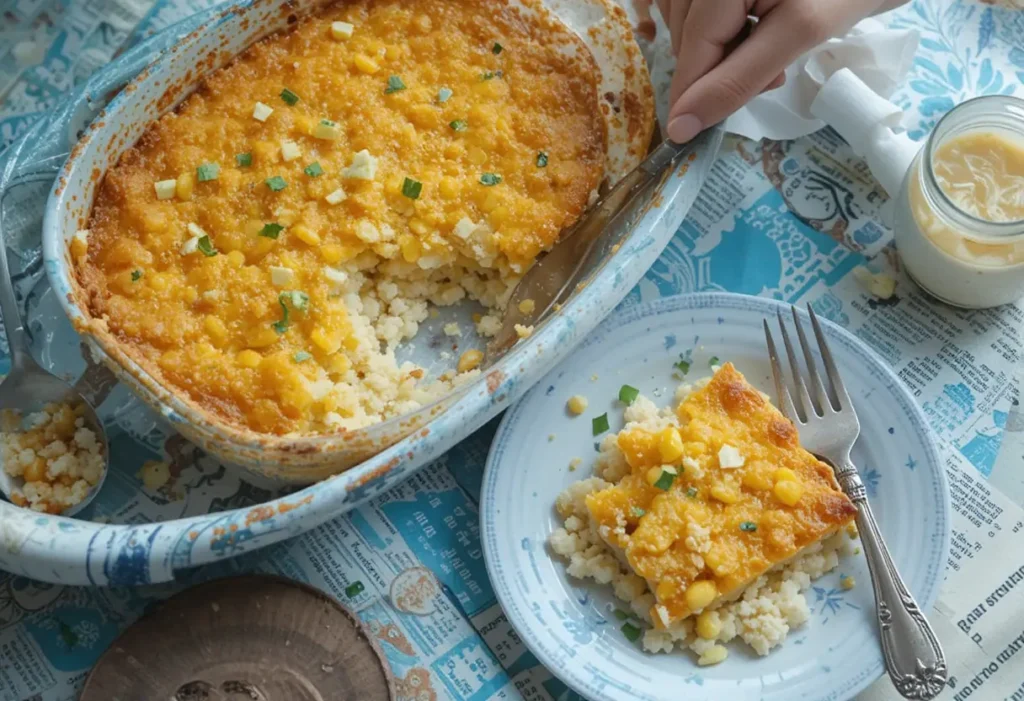Knowing when your corn casserole is ready is key. It’s rewarding to serve a dish that looks and tastes great. The perfect corn casserole has a comforting feel and a golden color. In this guide, I’ll show you how to check if your corn casserole is done. We’ll look at the important signs to ensure your dish turns out well.
Key Takeaways
- Understanding cooking times is essential for perfect corn casserole.
- Visual cues include a golden brown top and bubbling edges.
- Aroma plays a significant role in determining readiness.
- Checking the internal temperature helps ensure proper doneness.
- Using a toothpick or knife can effectively test for completion.
- Adjust cooking times based on the size of your pan.
- Avoid overcooking by being proactive with checks.
Understanding Corn Casserole Baking Time
Getting the baking time right is key for a great corn casserole. It usually takes 45 to 60 minutes in a 350°F oven. But, several factors can change this time. Let’s look at what affects cooking time.
Typical Cooking Duration for Corn Casserole
The usual time range is 45 to 60 minutes. But, the exact time can vary. An oven’s accuracy can cause small differences. So, it’s important to watch the dish closely towards the end.al cues, you can ensure consistent success with your recipe.
Choosing the right approach is just as crucial for other casseroles. For inspiration, check out the recipe for Old-Fashioned Cheesy Cornbread Casserole, which explains how to balance moisture and flavor effectively.

Factors Influencing Cooking Time
Several things can change how long corn casserole takes to cook. Knowing these can help you get better results:
- Oven Type: Conventional ovens might not heat evenly like convection ovens do, affecting cooking time.
- Altitude: At higher altitudes, cooking time can be longer because of lower air pressure.
- Casserole Dish Material: Glass or ceramic dishes take longer than metal pans, which heat up faster.
- Batch Size: Bigger batches or thicker casseroles need more time to cook.
| Factor | Impact on Cooking Time |
|---|---|
| Oven Type | Convection ovens generally reduce cooking time by about 25%. |
| Altitude | Cooking time may increase by around 2-3 minutes for every 1,000 feet of elevation. |
| Casserole Dish Material | Glass or ceramic dishes may add 5-10 minutes to cooking time versus metal pans. |
| Batch Size | Larger batches can increase cooking time significantly, potentially up to 15-20 minutes. |
By understanding these factors, I can make a corn casserole that everyone loves.
Identifying Signs of Cooked Corn Casserole
When it comes to judging the signs of cooked corn casserole, both visual cues and aromas play a crucial role. These indicators can help me determine when my dish is ready to grace the dining table.
Visual Indicators of Doneness
Looking for a few specific visual cues will help me assess the casserole’s readiness without cutting it open. I aim for:
- Golden Brown Edges: The edges should develop a rich golden hue, indicating that they are nicely baked.
- Set Center: The center should look firm rather than jiggly, showing that it has fully set during baking.
- Bubbling Appearance: A slight bubbling around the edges adds visual confirmation that the casserole is hot and ready.
The Role of Aroma in Determining Readiness
The wonderful aroma emanating from the oven can be a delightful sign of cooked corn casserole. A fragrant, sweet corn scent often indicates the dish is at peak flavor. As I prepare to check for doneness, the smell of baked corn and hints of buttery goodness provide reassurance that it is nearly time to serve up this comforting dish.
For a deeper understanding of corn-based dishes, explore What Is the Difference Between Corn Casserole and Cornbread?. This guide explains how preparation and baking methods influence the final product.
Troubleshooting Common Issues
Undercooked Center
- Cover the casserole with foil and return it to the oven for five-minute increments. Check the doneness after each interval.
Preventing Overbaking
- Monitor the dish during the final 10 minutes of baking. This step ensures you remove it at the right time.
- Opt for a glass or ceramic dish, which distributes heat evenly.
Making Corn Casserole Ahead
Corn casserole stores well in the refrigerator, but reheating can slightly alter the texture. Learn more about storage tips in the article Does Corn Casserole Need to Be Refrigerated?.

How to Tell When Corn Casserole Is Done?
Figuring out when corn casserole is ready involves several signs. Timing is key, but it’s not the only thing to watch. I’ve found that looking at both visual and texture clues helps a lot.
The first sign I look for is a golden brown top. This tells me the casserole has a nice crust and is cooked inside. The edges should also be slightly bubbly, showing it’s evenly heated and ready.
Texture is also important. When I dig in with a spoon, I want it to feel firm but creamy. If it’s too runny, it needs more cooking. And don’t ignore the smell; a rich, buttery aroma means it’s almost time to eat.
“Perfectly cooked corn casserole should have a dry, almost set surface while maintaining a slight creaminess inside.”
By following these steps and paying attention to the visual and textural cues, you can confidently create a perfectly baked corn casserole. For more inspiration, learn about its origins in the article Who Invented Corn Casserole?.
Checking Corn Casserole Doneness
Figuring out if your corn casserole is cooked can be tricky. But, I’ve found two easy methods that work well. You can use a toothpick or a knife to check if it’s done. Both ways help you know without messing up your dish.
Using a Toothpick for Testing
Testing with a toothpick is simple. Just stick it into the casserole’s center. If it comes out clean, your casserole is ready. This method is quick and doesn’t mess up your dish while it cooks.
What to Look for with a Knife Test
The knife test is another good way to check if your casserol is ready. Insert a knife gently into the middle. If it slides in easily, your casserole is done. But, if it feels sticky or gooey, it needs more cooking. Keep testing until it’s just right.
Corn Casserole Doneness Indicators
Several indicators can help you know when corn casserol is done. Look at the internal temperature, visual signs, and texture. These will help you serve a perfectly baked casserole.
Corn Casserol Internal Temperature
The perfect internal temperature for corn casserol is about 185°F. This ensures it’s cooked well and the flavors mix well. Using a food thermometer makes it easy to check and know it’s ready.
Visual Cues: Golden Brown and Bubbling Edges
Look for a golden brown top and bubbling edges to know it’s done. These signs make the dish look great and show it’s cooked right. They help avoid undercooking or overcooking.
Texture Checks for Perfect Consistency
Getting the right texture is key for a great corn casserol. Shake the dish gently to see if the center is firm. A good casserol should be firm but not soggy. If it feels right, it’s ready to eat.
Corn Casserol Doneness Tips
Getting your corn casserole just right is all about timing and pan size. The right pan size ensures even cooking and perfect doneness. Larger pans cook faster, while smaller ones take longer.
Timing Adjustments Based on Pan Size
Here are some practical corn casserol doneness tips related to pan size:
- For 9×13 inch pans, plan for the standard cooking time, generally 45-55 minutes.
- For smaller 8×8 inch pans, check for doneness around 35-45 minutes.
- If using a deeper dish like a 2-quart casserole, extend cooking time to approximately 60-70 minutes.
How to Avoid Overcooking
It’s easy to overcook your corn casserol, but it’s key to keep it creamy. Here are some tips:
- Monitor closely during the last 10-15 minutes of baking. A reliable toothpick or knife test can indicate doneness effectively.
- Remove the casserol when it’s slightly undercooked, as residual heat will continue cooking the dish.
- Allow the casserol to rest for about 5-10 minutes before serving; this helps achieve the right consistency.
| Pan Size | Standard Cooking Time | Adjustment Considerations |
|---|---|---|
| 9×13 inch | 45-55 minutes | Typical cooking time, check for bubbling edges. |
| 8×8 inch | 35-45 minutes | Thinner layers may cook faster, keep an eye on the texture. |
| 2-quart casserole | 60-70 minutes | Thicker mixture will retain heat longer, so start testing early. |
By following these corn casserol doneness tips, you’ll make a delicious dish every time. And you’ll avoid the common mistake of overcooking.
Conclusion
When it comes to knowing when corn casserole is done, a few key things matter. Knowing the right baking time is important. Also, looking for visual and smell signs of readiness is crucial.
As I mentioned earlier, watching for the internal temperature, the edges bubbling, and the golden color helps. Using a toothpick or knife can also confirm if it’s done right.
Learning these signs gives you the confidence to make a delicious corn casserole. It’s sure to be a hit at any event. Now, you’re ready to make a corn casserol that will wow everyone!
FAQ
How do I know when corn casserol is done?
To check if corn casserol is done, look for a golden brown top and bubbling edges. A set center is also a sign. You can also use a toothpick or knife test. If it comes out clean, it’s ready.
What is the typical cooking time for corn casserol?
Corn casserol usually bakes for 45 to 60 minutes at 350°F. But, cooking time can change based on oven type and altitude. Always watch it closely.
What are some signs of cooked corn casserol?
Look for golden brown edges and bubbling sides. A firm center is also a good sign. A sweet corn aroma will fill your kitchen when it’s almost done.
How do I test the doneness of corn casserol?
Use a toothpick to test doneness; it should come out clean. Or, try a knife; it should slide through without resistance.
What is the ideal internal temperature for corn casserol?
The ideal internal temperature is about 185°F. This ensures it’s cooked right while keeping the texture perfect.
How can I avoid overcooking my corn casserol?
Watch your casserol closely towards the end. Larger pans might need earlier checks, as they cook faster.
Why is the aroma important in determining corn casserol readiness?
A sweet corn scent means it’s almost done. It’s a key indicator, along with visual signs.
What should I look for with a knife test?
The knife should glide through easily. If it meets resistance or comes out wet, it needs more time.
How can I ensure my corn casserol has a perfect consistency?
Aim for a firm yet moist consistency. Monitor cooking time, use tests, and ensure the right ingredient ratios for the best result.


1 thought on “How to Tell When Corn Casserole Is Done?”
Comments are closed.